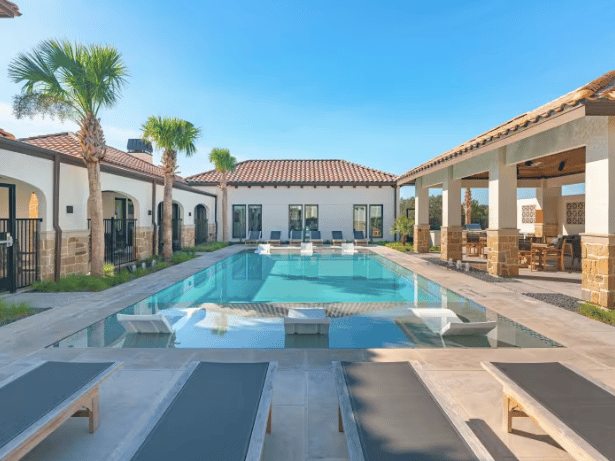Wall Street Is Betting Billions on Rental Homes as Ownership Slips Out of Reach
Build-to-rent homes offer upscale amenities and desirable locations
Wall Street firms buying or developing single-family homes are betting billions of dollars on people like Adrianne Harlow.
The 45-year-old women’s basketball coach was moving from Alabama to Florida, where she looked to buy a home for herself and her infant daughter. She became discouraged by the limited selection, steep prices and high mortgage rates.
Then Harlow looked at similar homes for rent. In July, she moved into a four-bedroom house with a backyard, porch, patio and garage, part of a single-family rental neighborhood known as Oak Grove, about 40 miles north of Orlando. Her landlord is Main Street Renewal, a subsidiary of the large real-estate investor Amherst.
“I haven’t regretted any of it,” Harlow said. “I’ve been able to make it my home.”
As more millennials enter their prime home-buying years and start families, many are finding themselves priced out of the most coveted suburban neighborhoods with top-flight schools.
A growing number of those their age, or even older, are turning instead to upscale single-family rentals nearby. Developers are eager to capture that demand, even if that sometimes means building fewer homes for sale.
AvalonBay Communities, one of the largest multifamily real-estate investment trusts, is the latest to step up in the build-to-rent business. It recently purchased a set of 126 build-to-rent townhomes in Bee Cave, Texas, for $49 million.
That was the firm’s first acquisition of build-to-rent homes. While those houses represent a small part of its overall portfolio, the firm expects to invest over $1 billion into the build-to-rent sector going forward.
“We think we’re really in the early stages of what could be a pretty significant, almost new asset class,” said AvalonBay Chief Investment Officer Matt Birenbaum.
AvalonBay is part of a rush of institutional investors and private-equity firms pouring into the build-to-rent market, a subsector where developers construct neighborhoods of single-family homes for the sole purpose of leasing them to tenants, rather than selling them to prospective homeowners.
They are aiming to capitalize on a growing cohort of people who felt they would become homeowners as they move to the next stage of life and start a family but are increasingly viewing renting as a more affordable long-term option.
From 2021 to 2023, the share of build-to-rent housing starts doubled to 10% of overall single-family housing, according to the National Association of Realtors’ analysis of U.S. Census Bureau data.
Blackstone, Invitation Homes and Pretium Partners are among the big Wall Street firms expanding their build-to-rent portfolios as demand for rental housing balloons.
For the first time in more than two years, the growth of the U.S. renter pool has outpaced that of homeowner households for the past four quarters, according to a Redfin analysis of U.S. census data. In the third quarter, the formation of renter households increased 2.7%, three times faster than homeowner households and the second fastest rate for renters since 2015.
The rapidly expanding renter pool is a direct response to the widening gap between how expensive it is to rent versus own a home in the U.S., especially as mortgage rates stay heated at nearly 7% with no immediate signs of cooling.
Home prices hover near record highs and the average monthly mortgage payment for a new home is 38% more expensive than apartment rents, according to a CBRE report from earlier this year.
Sunbelt states are emerging as the hottest build-to-rent markets, due to more land availability and an influx of workers fueling demand. Even AvalonBay, which houses much of its portfolio in coastal areas, said it is focusing its build-to-rent expansion in Sunbelt regions such as Raleigh-Durham in North Carolina and Austin, Texas.
Developers and investors say their build-to-rent communities offer a solution to the country’s persistent housing shortage. And they say their rental homes allow tenants to live in the sort of desirable neighborhoods where they often can’t afford to buy.
AvalonBay’s terracotta-roofed houses in Bee Cave, for example, feature many of the hallmarks of a high-end suburban neighborhood including backyards, balconies, patios, a communal pool and a gym. The neighborhood is roughly a 10-minute drive from downtown Austin.
Some tenants say they prefer the lifestyle and convenience of renting, even though they lose a key pathway to building equity and generational wealth. For instance, instead of troubleshooting pesky maintenance issues, they just call their landlord.
But some economists say that the build-to-rent movement is shifting developers’ attention away from the home-buying market where more supply is needed to normalize prices.
In the Sunbelt, for example, instead of new housing supply “coming onto the open market,” it is “being diverted” for build-to-rent activities, Moody’s director of economic research Ermengarde Jabir said.
Government regulators and housing officials are also keeping tabs on the influx of big institutional investors building out their single-family rental portfolios.
In September, Invitation Homes, the biggest single-family rental operator in the U.S., agreed to pay the Federal Trade Commission $48 million to settle charges related to deceptive rental pricing practices and unfair evictions.
“When institutional investors or larger landlords own the rental units, we see an increase in the number of evictions for tenants,” said Ruth Jones Nichols, a former housing official in the Biden administration who now serves as executive vice president of programs at the Local Initiatives Support Corp. “That’s something we really want to keep an eye on.”
Birenbaum of AvalonBay said build-to-rent developments don’t come at the cost of for-sale supply because the firm isn’t acquiring rentals that an individual homeowner would have otherwise purchased.
“We are not competing with individuals trying to buy individual homes in the private market,” he said.



